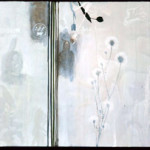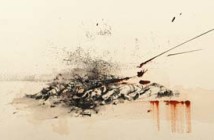Upon viewing Duane Slick’s new work at the Nielsen Gallery, one may recall Andy Warhol’s 1985 silkscreen prints of company logos and symbols or collaborative paintings with the young African-American graffiti artist with Haitian roots, Jean-Michel Basquiat. In “Pre-Contact Landscape in Milkweed Patch”, one of Slick’s finest paintings in the exhibition, a high-flying Pegasus recalls Warhol’s "Mobil" and the logos "Artforum" and "Art in America" (esteemed publications that contribute to the making of art stars) bring to mind his prints attributed to Paramount, the powerful film star maker. Images of Native American men remind one of Basquiat’s paintings alluding to the continued oppression of African-Americans.In the painting “Arm and Hammer II”, a Warhol image of the famous logo of a white muscular arm holding a hammer (once owned by Armand Hammer, the art collector and petroleum executive) joins the same image transformed through Basquiat’s graffiti- illustrating the differences in power between struggling African-Americans and white corporate giants.
Aside from these references, the similarity between Slick and Warhol and Basquiat ends. Warhol celebrated American consumer culture and its capitalistic definition of success. Although Basquiat addressed racism towards African Americans, he did not set a good example as a minority given a golden opportunity. He rose to fame very quickly, mismanaged his money, overdosed, and died - leaving his dealers and collectors the advantage of still gaining monetarily. Basquiat came to symbolize the money, hype and destructive excess of the 80’s.
Duane Slick beats to the sound of a different drummer. He reveals the increasingly weak status of Native Americans in a predominantly white corporate America yet the strength of his message extends universally. It causes one to think of the impact toxic corporate consumables (e.g. fuel hungry vehicles, silicone implants, and McDonalds) is having on the world as a whole. Slick denounces greedy corporations who hungrily destroy the world’s environment and natural resources and openly expresses his opposition towards the American government’s deceptive veneer. Like a milky white sheath, multiple layers of acrylic paint almost shield the truth of the war on humanity and wildlife. Symbols of Native American culture such as mule deer (victims of the neurological Chronic Wasting Disease impacting Winnebago county), coyotes, milkweeds and irises (indigenous plants threatened by their loss of habitat) and corporate icons (powerful determinants of the future) act as messengers of a fading existence. By combining these images under a fog-like barrier, accented by lines, patches of color or smears of brown or black paint on the surface - further provoking one to examine the work more closely, Slick illustrates that in the end, nobody will win. As the natural gifts of the earth and its multifarious populations continue to be destroyed in the name of greed, religion, ignorance, and cultural misunderstandings, the planet will increasingly diminish into nothingness.
- Duane Slick, Pre-Contact Landscape in Milkweed Patch, acrylic on linen, 2005.
- Duane Slick, Red Coyote, acrylic on linen, 2005.
- Duane Slick, Hunters and Gatherers, acrylic on linen, 2005.
Links:
Nielsen Gallery
"Duane Slick: A Wolf in the Irises" is on view September 17 - October 23, 2005 at Nielsen Gallery.
All images are courtesy of the artist and Nielsen Gallery.






